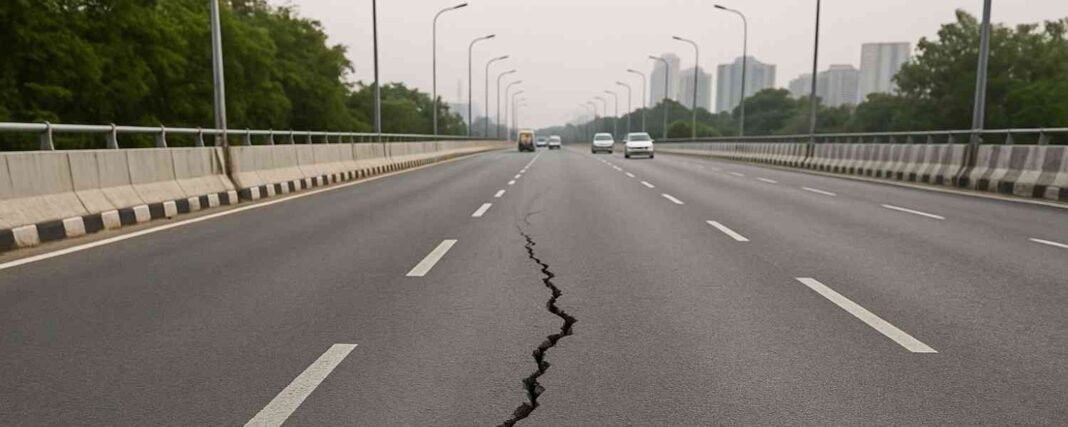Cracks in Prestige: Delhi’s Ranjit Singh Flyover Falls into Disrepair
In a troubling reflection of Delhi’s civic infrastructure woes, the Ranjit Singh Flyover on Barakhamba Road—once upgraded as part of the city’s facelift for the G20 Summit—has developed severe cracks and fallen into a state of neglect, barely three years after costly repairs. Located near some of the capital’s most high-profile landmarks, including corporate headquarters, luxury hotels, and political offices, the flyover now presents a hazardous and unsightly stretch in the heart of the city.
Stretching 900 metres, the flyover begins from Barakhamba Road and connects to major locations like Ramlila Maidan, Delhi Gate, Zakir Hussain College, and Turkman Gate. Originally constructed in 1982 for the Asian Games, it has since become a crucial traffic corridor between New and Old Delhi. But for commuters, what was once a symbol of urban efficiency is now a jarring, pothole-ridden experience—especially dangerous during monsoon rains, as water seeps into widening cracks.
Shabby After the Shine
The flyover’s condition stands in stark contrast to the city’s current month-long sanitation and maintenance drive. A survey conducted on-site on Thursday revealed that much of the work carried out in 2022–23—when the flyover was given a ₹4 crore makeover—has already deteriorated. The road surface is cracked and uneven, concrete panels are broken or missing, and the noise barriers lining the flyover have large, gaping holes.
Most glaringly, a stretch near the BJP headquarters, once decorated to commemorate 75 years of India’s independence, now serves as an open urinal. The irony is hard to miss: an area once beautified with LED lights and national flags—at an additional cost of ₹2 crore—has become a symbol of civic apathy.
Commuters Raise Alarm
Daily users of the flyover are both frustrated and concerned about safety. Mohammed Zia, a 31-year-old clinic employee working nearby, said, “The road has several potholes and bumps, especially on the northern side. I’ve seen people fall and injure themselves. It’s dangerous.”
Jai Prakash Malhotra, 68, who travels the flyover daily to reach his medical shop, echoed the sentiment. “It’s been patched up many times, but it’s never truly fixed. The surface is so uneven that even slow-driving vehicles jolt.”
Shashi Kant, a shop owner near one of the flyover’s entry points, added that despite repeated patchwork, key stretches remain broken and poorly maintained. “Repairs should be done again—but this time, done right,” he stressed.
Short-Lived Repairs, Long-Standing Neglect
Over the years, the flyover has seen sporadic repairs, often driven by political events rather than planned maintenance. In 2018, before the inauguration of the BJP’s new headquarters, the structure received a cosmetic facelift with fresh paint and view-cutters. A more substantial revamp in 2022 included upgrades such as new expansion joints, crash barriers, and railings, alongside relaying of the road surface.
Despite these efforts, the lack of consistent follow-up and structural evaluation has left the flyover vulnerable. The total cost of the recent beautification and repair initiatives amounted to nearly ₹6 crore, prompting public concern over the sustainability and quality of these projects.
NDMC Promises Action
Acknowledging the issue, a senior official from the New Delhi Municipal Council (NDMC) confirmed that repair work would begin in the coming days. When questioned about sanitation and the open urination problem, the official admitted that it remains a city-wide challenge. “We will work towards improving cleanliness and raise public awareness in the area,” the official said.
A Larger Civic Lesson
The Ranjit Singh Flyover’s current state is not just a story of a single road—it’s emblematic of deeper issues in urban infrastructure planning, execution, and maintenance. Despite being in one of Delhi’s most visible and high-value zones, the flyover has suffered from poor upkeep, lack of accountability, and an apparent preference for short-term fixes over long-term solutions.
As commuters continue to navigate its treacherous path, the question remains: how long will Delhi’s infrastructure survive on cosmetic upgrades, and when will real, lasting repair work begin?








